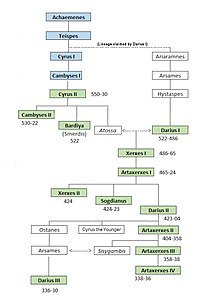Pissuthnes
Pissuthnes | |
|---|---|
| Πισσούθνης | |
 Anonymous portrait of a Satrap of Asia Minor, around the time of Pissuthnes. From a coin of Ionia, Phokaia, circa 478-387 BCE. | |
| Satrap of Lydia | |
| In office 440 – 415 BCE | |
| Preceded by | Artaphernes |
| Succeeded by | Tissaphernes |
| Personal details | |
| Born | 5th century BCE |
| Died | 5th century BCE Susa, Lydia, Persian empire |
| Military service | |
| Allegiance | |

Pissuthnes, also known as Pissouthnes, (Old Persian: *Pišišyauθnaʰ; Ancient Greek: Πισσούθνης Pissoúthnēs) was an Achaemenid satrap of Lydia, which included Ionia, circa 440–415 BCE. His capital was Sardis.[1][2] He was the son of Hystaspes, probably himself the son of Darius I, which shows his Persian origin and his membership of the Achaemenid dynasty.[3] He held the satrapy for over twenty years, and became extremely rich as a consequence.[4]
He helped the Samians in the Samian Revolt against Athens, and supported various oligarchical movements against Athens along the coast of Asia Minor.[5]

He revolted against the Persian king Darius II Nothus between 420-415 BCE.[6] He recruited Greek mercenaries under the generalship of Lycon for his campaigns.[7] Tissaphernes, who was sent by the King to suppress the revolt of Pissuthnes, managed to bribe Lycon, and then brought Pissuthnes to Susa where he was executed.[8] Tissaphernes became his successor as Satrap of Lydia.[9]
Pissuthnes had a natural son named Amorges, who continued the rebellion against the Persian king.[10]
References
[edit]- ^ Briant, Pierre (2002). From Cyrus to Alexander: A History of the Persian Empire. Eisenbrauns. p. 581. ISBN 9781575061207.
- ^ Delphi Complete Works of Thucydides (Illustrated). Delphi Classics. 2013. p. 1402. ISBN 9781909496767.
- ^ Rawlinson, George (2018). The Persian Empire. Endymion Press. p. 197. ISBN 9781531295752.
- ^ Rawlinson, George (1885). The Seven Great Monarchies of the Ancient Eastern World: Or, The History, Geography and Antiquities of Chaldæa, Assyria, Babylon, Media, Persia, Parthia, and Sassanian Or New Persian Empire. J. W. Lovell Company. p. 507.
- ^ The Cambridge Ancient History. Cambridge University Press. 1970. p. 143. ISBN 9780521233477.
- ^ Briant, Pierre (2002). From Cyrus to Alexander: A History of the Persian Empire. Eisenbrauns. p. 675. ISBN 9781575061207.
- ^ Briant, Pierre (2002). From Cyrus to Alexander: A History of the Persian Empire. Eisenbrauns. p. 578. ISBN 9781575061207.
- ^ Rawlinson, George (2018). The Persian Empire. Endymion Press. p. 197. ISBN 9781531295752.
- ^ The Cambridge Ancient History. Cambridge University Press. 1970. p. 464. ISBN 9780521233477.
- ^ Delphi Complete Works of Thucydides (Illustrated). Delphi Classics. 2013. p. 2127. ISBN 9781909496767.

